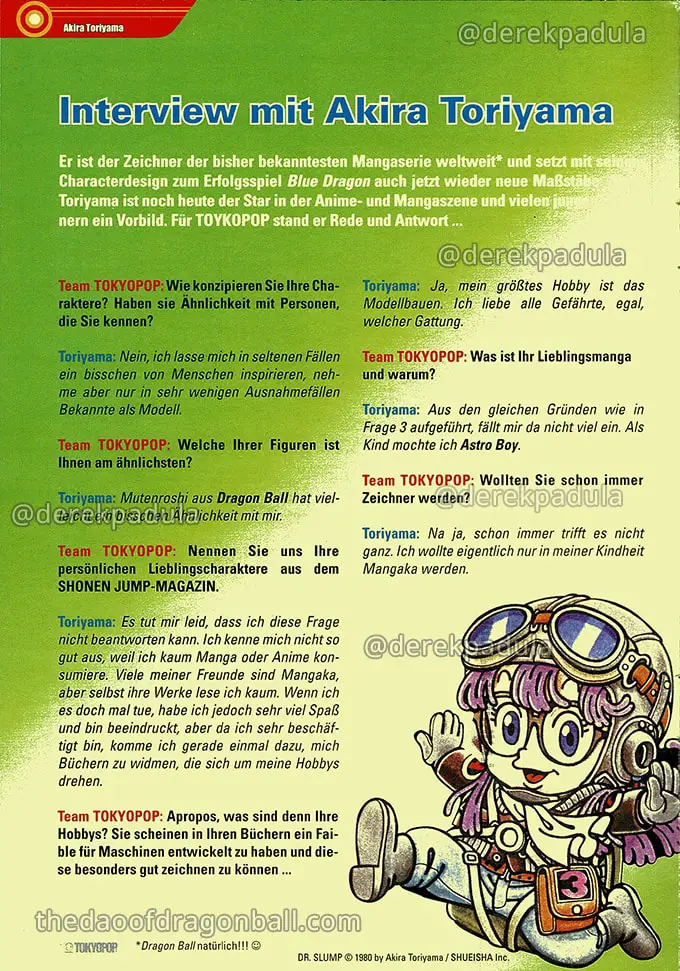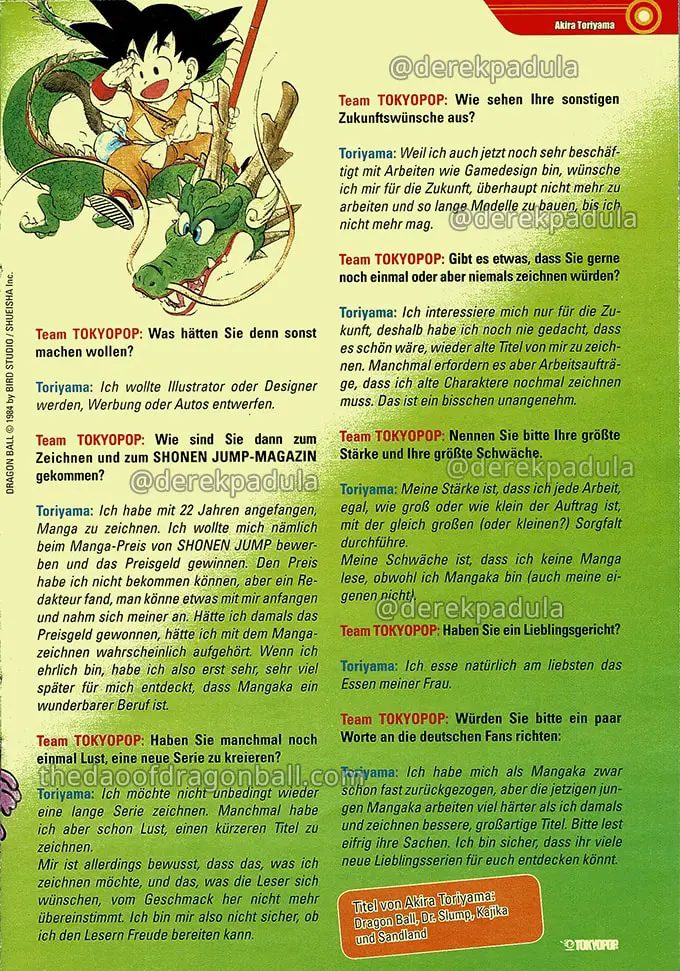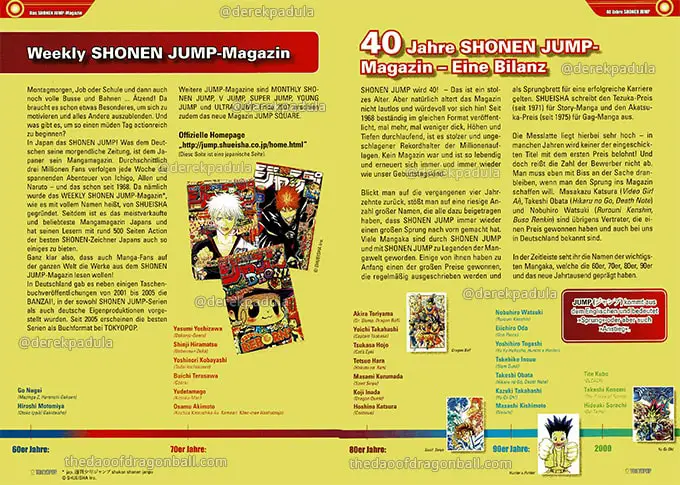Akira Toriyama’s Lost Interview with Tokyopop Germany!

Read a long-lost interview with Akira Toriyama published in the Tokyopop Germany magazine in 2008!
This interview consists of two parts: First with Akira Toriyama, and then with his editor, Kazuhiko Torishima.
I received this publication from a German reader who contacted me right after Akira Toriyama’s death was announced on March 8, 2024. It consists of 5 pages contained within a free magazine published in Germany. The reader found it in a bookstore where he used to buy manga. Please thank this fan for sharing this once-lost Toriyama artifact!
Notes:
There is no record of Toriyama’s original Japanese words. I translated everything from German into English.
I’m publishing the interview up front, followed by my history report of this publication.
I’ve added explanatory footnotes to Toriyama’s comments, which you can read after the interview and history.
I chose not to edit the images to replace the German text with English. This was done in order to preserve the original content, and because it’d be so difficult on top of what I’ve gone through this week.
Everything that follows here is a direct quote until the end of the interview.
Tokyopop Germany Front Cover

Title: The World of Shonen Jump
Blue Star: Free
Gold Star: 40 Years of Shonen Jump
Front Headline: Bleach – Shonen Jump Manga. [by] Tite Kubo. Volume 20 in stores now!
Banner 1: Star Mangaka Akira Toriyama in an interview! With exclusive info just for you!
Banner 2: Big raffle campaign: Win the Xbox 360 with the hit game Blue Dragon!
Banner 3: Choose the coolest Shonen Jump hero of 2008! You decide who is best!
Banner 4: Many extras: Author interviews, memory, puzzle pages, charts, and, and, and …
Genre Label: Action
Call-To-Action: Visit us at www.tokyopop.de
Tokyopop Interview with Akira Toriyama Page 1

Interview with Akira Toriyama
Introduction: He is the illustrator of the most famous manga series in the world*,[1] and is now setting new standards with his character designs for the hit game Blue Dragon.[2] Toriyama is still the star in the anime and manga scene today, and a role model for many people.[3] He was available to answer questions for TOKYOPOP…
Team TOKYOPOP: How do you design your characters? Are they similar to people you know?
Toriyama: No, in rare cases I get a little inspiration from people, but only in very few exceptional cases do I use people I know as models.[4]
Team TOKYOPOP: Which of your characters is most like you?
Toriyama: Muten Rōshi from Dragon Ball might have a bit of a resemblance to me.[5]
Team TOKYOPOP: Tell us your personal favorite characters from Shonen Jump Magazine.
Toriyama: I’m sorry, but I can’t answer that question. I don’t know much about it because I hardly consume manga or anime. Many of my friends are manga-ka, but I hardly read their works. However, when I do read it, I have a lot of fun and am impressed. But since I’m very busy, I barely even get around to reading books that revolve around my hobbies.[6]
Team TOKYOPOP: Speaking of which, what are your hobbies? In your books you seem to have developed a soft spot for machines and are particularly good at drawing them…[7]
Toriyama: Yes, my biggest hobby is model building.[8] And I love all animal companions, regardless of their species.[9]
Team TOKYOPOP: What is your favorite manga, and why?
Toriyama: For the same reasons as listed in question 3, I can’t think of much. I liked Astro Boy as a kid.[10]
Team TOKYOPOP: Have you always wanted to be an illustrator?
Toriyama: Well, ‘always’ is not quite true. I actually only aspired to be a manga-ka when I was a child.[11]
Tokyopop Interview with Akira Toriyama Page 2

Team TOKYOPOP: What else would you have wanted to do?
Toriyama: I wanted to be an illustrator or graphic designer, designing advertising or cars.[12]
Team TOKYOPOP: How did you get into drawing, and then for Shōnen Jump Magazine?
Toriyama: I started drawing manga when I was 22 years old. I wanted to apply for the Shōnen Jump manga prize and win the prize money. I couldn’t get the prize, but an editor thought they could do something with me and took me on board.[13] If I had won the prize money back then, I would probably have stopped drawing manga. If I’m honest, it wasn’t until much, much later that I discovered that being a manga-ka is a wonderful job.[14]
Team TOKYOPOP: Do you ever feel like creating a new series again?
Toriyama: I don’t necessarily want to draw a long series again. But sometimes I feel like drawing a shorter title. However, I am aware that what I want to draw and what readers want no longer match in taste. So, I’m not sure if I can bring joy to the readers.[15]
Team TOKYOPOP: What are your other wishes for the future?
Toriyama: Because I’m still very busy with work like game character designs, my wish for the future is to not work at all, and to build models until I don’t like them anymore.[16]
Team TOKYOPOP: Is there anything you would like to draw again, or never draw?
Toriyama: I’m only interested in the future, so I never think that it would be nice to draw old titles of mine again. But sometimes work assignments require me to draw old characters again. This makes me feel a bit uncomfortable.
Team TOKYOPOP: Please state your greatest strength and your greatest weakness.
Toriyama: My strength is that I can do any work. No matter how big or small the job is, I’ll carry it out with the same amount of care. My weakness is that I don’t read manga, even though I’m a manga-ka (not even my own).
Team TOKYOPOP: Do you have a favorite dish?
Toriyama: Naturally, I prefer to eat my wife’s food.[17]
Team TOKYOPOP: Would you please say a few words to the German fans.
Toriyama: I have almost retired as a manga-ka, but the current young manga-ka work much harder than I did back then, and draw better—great titles.[18] Please read their stuff diligently. I’m sure you’ll discover many new favorite series for yourself.
End Banner: Titles by Akira Toriyama: Dragon Ball, Dr. Slump, Kajika, and Sand Land
History of Toriyama’s Interview with Tokyopop
The history of this interview and its publication date require explanation, and it took a lot of research to figure out.
Free
The cover states that this magazine is free, and the German reader told me that half the magazine is filled with ads and promos for different manga, rather than manga chapters, which suggests it was meant to be a teaser introduction to the medium. It’s the kind of publication that would be given away at bookstores or conventions to generate future sales.
This is odd, given that it contains these interviews with Toriyama and Torishima, who I will now define as the greatest manga-ka and editor duo in Shōnen Jump history.
These interviews have never appeared anywhere else to my knowledge, including Tokyopop’s American publications, but even if they had, it feels a bit disrespectful that Tokyopop would give this content away, as if they didn’t know what else to do with it.
But in the end it’s good for us that they did.
Publication Date and Credit
The publication date of this magazine is 2008, and the front cover celebrates “40 Years of Shonen Jump,” which was founded in Japan in 1968 by Shūeisha.
To this end, there’s an article on the inside that details the timeline of Japanese Shōnen Jump manga properties, which includes some that were localized in Germany.

Shōnen Jump publications in Germany started with the BANZAI! magazine from 2001 to 2005, published by Carlsen Comics. Carlsen still owns the rights to Dragon Ball to this day (along with Naruto, One Piece, and other shōnen staples.
But according to this timeline, starting in 2005, Tokyopop Germany published many of Shūeisha’s other series, such as Bleach and Death Note.
Tokyopop is an American distributor, licensor, and publisher of anime and manga based out of Los Angeles. Tokyopop’s German division in Hamburg produces German translations of this content, and original German and English manga.
They published their first manga in 2004 and entered a strategic partnership with Shūeisha in 2006, before these interviews were held. This may have been what led to this encounter.
But as stated, Tokyopop doesn’t publish Dragon Ball, because the rights were already acquired by Carlsen Comics.
So, this is another odd point, in that Tokyopop didn’t own the rights to Dragon Ball, Dr. Slump, or Toriyama’s other manga, yet nevertheless conducted and published these interviews.
On a positive note, in this image, Akira Toriyama’s Dr. Slump and Dragon Ball are listed at the very top of the ‘80s column among “the names of the most important manga-ka who shaped the ‘60s, ‘70s, ‘80s, ‘90s, and the new millennium.”
Bravo, Toriyama!
Location
According to this Tokyopop magazine’s introduction to their interview with Torishima-san (which you’ll read in part 2), his interview was held at the Frankfurt Book Fair (Frankfurter Buchmesse), the world’s largest trade fair for books.[19] Publishers send their representatives to this fair to sell the translation rights to their author’s books to foreign companies.
Given that Torishima’s interview follows Toriyama’s, it can be presumed that Toriyama’s interview was also held at the same event. Therefore, it’s likely that Toriyama and Torishima were there to promote Shūeisha’s intellectual properties, or on their own to promote Bird Studio, or something else for a different company.
Or maybe it’s as simple as Torishima going there to do this, and he asked Toriyama to come along since he knew was free and liked Germany. Who knows?
Tokyopop Germany was there because of course they would be, as Hamburg is only a few hours from Frankfurt and they’re in the publishing business. So, they likely met Toriyama and Torishima at the event and held an interview session.
But then why has nobody heard of Toriyama visiting Germany in 2007 until now?
It could be on account of the Frankfurt Book Fair being a 5-day event, where the first three days are held behind closed doors for industry professionals, and the remaining weekend is open to the public. Toriyama and Torishima may have only attended when it remained private, per Toriyama’s preferences to remain obscure and avoid crowds. But that’s just speculation based on what I know of his personality.
Interview Time
The Frankfurt Book Fair is held once a year, in mid-October.
Toriyama drew an original version of his Robottoriyama likeness for the opening page of these interviews with a copyright date of 2007 (found on the right-hand side of the page), but the publication of this interview came out in 2008. Given that the Frankfurt Book Fair is held in October, this suggests that Toriyama visited in 2007 and it took a few months for the magazine to come out.
Furthering this argument, I suspect it came out in the first months of 2008. This is because on the opposite page of the Robottoriyama drawing there’s an ad for the Pokémon Battle Revolution game for the Nintendo Wii where you could enter a contest to win it, and the deadline for the contest was June 1, 2008. Since the Frankfurt Book Fair is held in October, the interview couldn’t have been held during the 2008 fair held later that year.
Therefore, I conclude that the interviews were held in 2007, but published in 2008.
Yet because it’s standard practice to go by the publication date for a title, not the interview date, we’ll call this the ‘Akira Toriyama and Kazuhiko Torishima Tokyopop Germany Interviews (2008).’
Akira Toriyama’s Trips to Germany
To my knowledge there is no other evidence of Akira Toriyama or Kazuhiko Torishima visiting Germany in 2007 outside of these interviews.
However, this is the second interview Akira Toriyama conducted in Germany, after his 2004 interview with BANZAI! magazine. This was held at the 2004 Leipzig Book Fair after he was invited by Carlsen Comics, the German licensor of Dragon Ball.
And prior to this, Toriyama had visited Germany in 1990 for the Formula 1 race where he met legendary racer Ayrton Senna.
Toriyama’s visit with Ayrton Senna inspired his Battleman F1 manga, which I translated and made available for you to read.
And in his interview with BANZAI!, Toriyama said, “Twenty years ago, I was in Hockenheim for a Formula 1 race. At that time everyone was nice and helpful to me and I got a very good impression of Germany.”
This would have meant he also attended for the 1984 race. However, I don’t have evidence of this trip, and there’s a chance he meant the 1990 race and said ‘twenty years ago’ in general.
Thus, Toriyama visited Germany at least three times, but maybe four, and these visits produced some great content for us to explore.
More Battleman!
Speaking of Formula 1, did you know that Akira Toriyama published a SECOND Battleman F1 manga?
Of course not, because nobody outside of Japan knows that!
As luck would have it, I’m sitting on the translation of another 4 pages of Toriyama’s F1 manga that were only published in Weekly Shōnen Jump!
No promises on when I’ll publish it, but it’s a work in progress.
Conclusion of Toriyama’s Tokyopop Interview
How did you feel about Toriyama’s lost interview with Tokyopop in Germany?
Did you learn anything new?
I found it comforting to read Toriyama’s words in a fresh interview after his sudden death. It felt like I could hear his voice and picture his mannerisms while speaking. This helped motivate me to work harder on translating and formatting this article during such a difficult time after his passing.
Come back next week for the second part of the Tokyopop Germany magazine, and their interview with Toriyama’s editor, Kazuhiko Torishima!
Update on 3/20/2024: Read the Kazuhiko Torishima part of the interview series.
Footnotes
[1] “He is the illustrator of the most famous manga series in the world” – “Dragon Ball, of course!!!” (Ed. This footnote was in the original text)
[2] Blue Dragon (December 7, 2006) was an open-world RPG with character designs by Akira Toriyama, published by Microsoft as an Xbox 360 exclusive.
[3] Toriyama’s Dragon Ball and Dr. Slump were still a hot item in the early-to-mid 2000’s in America and Europe. But in 2008, it’s arguable whether or not Toriyama was “still the star in the anime and manga scene today” relative to Japan, given the rise of Naruto, One Piece, and Bleach in the ’90s and aughts, and Toriyama’s lack of serialized comics. But of course, at this time Dragon Ball was still the world’s #1 best-selling manga of all time, prior to being eclipsed by One Piece, between 2008 – ’10. There’s no debate about Toriyama being “a role model for many people.” That was, and remains, true.
[4] The most famous example of Toriyama using a person he knows as a model is with his editor, Kazuhiko Torishima, as the model for the evil inventor Mashirito in Dr. Slump, and the evil Demon King Piccolo in Dragon Ball. It’s funny for Toriyama to not explicitly mention Torishima here, given that Torishima traveled with him to the event, and may have been nearby him when he answered this question.
[5] As I argue in my Dragon Ball Culture books, Muten Rōshi is a proxy for some of Akira Toriyama’s hobbies, preferences, and perverted humor. When Toriyama says he “Might have a bit of a resemblance to me,” I feel like he’s downplaying the connection, as he has done in other interviews. Toriyama says it in the first place because there is a connection. Not visually with his age or face, but psychologically, in his interests.
[6] Akira Toriyama was friends with many manga-ka of his generation, and of the next who looked up to him, but he didn’t have much interest in leisure activities related to the medium of his career. Surprising as it may seem, he didn’t watch the Dr. Slump or Dragon Ball anime outside of a few occasional episodes.
[7] Toriyama has a “soft spot for machines” because he grew up with a father who was an auto mechanic, and Toriyama was surrounded by cars, motorcycles, and machines of all sorts.
[8] Toriyama often spoke of his love for model building, and how his office workspace was so overflowing with model kit boxes that he barely had room to draw. Many photographs of his office show these kits, and likewise in his illustrations.
[9] Toriyama owned many animal companions over the course of decades, including multiple dogs, cats, birds, amphibians, and fish. They were often the source of inspiration for characters and names in his work. For example, Beerus, the God of Destruction in Dragon Ball Super (2015), was modeled after his cat of the time.
[10] Astro Boy (April 3, 1952 – March 12, 1968, Japanese: Tetsuwan Atomu, 鉄腕アトム, by Tezuka Osamu) was the first hit manga for young boys, and was the most popular series among Toriyama’s generation of children (as Toriyama was born April 5, 1955). Toriyama has said elsewhere that he was inspired by the design of the titular Astro Boy’s metallic hair when designing the spikes in Son Gokū’s hair in Dragon Ball.
[11] Akira Toriyama says, “I actually only aspired to be a manga-ka when I was a child.” This means that he had this aspiration as a young boy, but as a teenager he aspired to be an illustrator and graphic designer. He became a manga-ka out of happenstance, and it’s in this career where he utilized his illustration and graphic design skills. It was not his dream job.
[12] Akira Toriyama went to a graphic design-focused high school. His first job out of school was as an illustrator for an advertising company. He loved cars his entire life, and drew many of them in his creative works.
[13] The editor Toriyama speaks of is Kazuhiko Torishima, who recognized Toriyama’s talent and fought for him at Shūeisha when the other editors didn’t believe he had potential.
[14] Toriyama entered the manga contest because he was unemployed and needed the cash, and he was a talented artist who thought he could win the prize, not so he could become a manga-ka. It was his innate talent and pursuit of reaching a higher level in his art for years to come that made him so successful. But as he says here, if he had won that prize, he would have moved on with his life. If that had happened, then the world would never have experienced Dragon Ball.
[15] Toriyama has commented elsewhere how his personal preferences are “perverse” and misaligned with reader’s preferences. His editors often forced him to change his work to be more in-line with reader’s tastes. Perhaps for this reason, Toriyama’s more personal and lesser-known works often didn’t sell as well. And for example, his eventual “shorter title” after this interview, Jaco the Galactic Patrolman (2013) seemed to have little relation to his other works until the final (eleventh) chapter, and fewer people have read it. His editor strongly suggested he tie the ending into Dragon Ball so that readers would care about it. This forced change then enabled Jaco to appear in Dragon Ball Super as a supporting cast member two years later.
[16] Between this interview in 2008, and up to the release of the film Dragon Ball Z: Battle of Gods (2013), Toriyama did not have as much creative output as his earlier years. But following the film’s release, Toriyama continued drawing and writing new works until his death, on March 1, 2024. The official announcement of his death stated that he had many works in progress that had yet to be revealed. Time will tell if they are. So, this comment is insightful, in that Toriyama wished for retirement, but did the opposite. This is likely due to him being asked to revise the script for Battle of Gods, which caused him to get more invested in the project and the series at large once again. He then wrote original screenplays for the subsequent films, and contributed a great deal to the Dragon Ball Super manga, and the Dragon Ball Daima anime, coming Fall of 2024.
[17] Akira Toriyama’s wife was the manga-ka with the pen name of Mikami Nachi. She quit her job upon marriage in order to support her husband, per the traditional Japanese custom. She was part of Toriyama’s company, Bird Studio, as they worked out of his home with Toriyama’s assistant who would come to his office.
[18] Toriyama did not retire as a manga-ka in 2008, nor soon after. At best, he was in a semi-retirement in regard to manga in particular. However, he did stop drawing the Dragon Ball manga, and this task was left to his protégé, Toyotarō, in Dragon Ball Super (2015).
[19] In 2015 I sent my own Dragon Ball Z book to Frankfurt through the Independent Book Publishers Association), but nobody bought the rights. And since then, I haven’t had the money to submit it again, or any others.
' . $comment->comment_content . '
'; } } else { echo 'No comments found.'; }